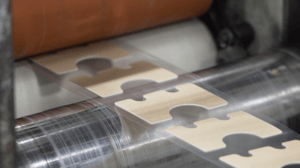So, you want to bond a couple of objects for an industrial solution. What’s the best way to do it?
Industrial bonding solutions are high-strength connections that require adhesives that fit the substrate's needs and application.
Over the years, Strouse has helped create many powerful industrial bonding and protective applications.
If you’re unsure whether to use tape or glue for your industrial adhesive solution, don’t worry; we’re going to go over the benefits of each so you can make a more confident choice.
What is Industrial Adhesive?
An industrial adhesive is a chemical compound that acts as a powerful bonding solution to join objects together.
The designation “industrial” leaves a wide spectrum of bonding applications such as connecting different part components and labels for product assembly.
Examples of industrial adhesives might include glue, hot melt, epoxy, and acrylic, which are used in sealing, joining, or fastening applications. Industrial adhesives come in the form of adhesive tape or a liquid adhesive depending on the substrates in need of joining.
Which Adhesives Are Used for Industrial Applications?
Between liquid adhesive and pressure-sensitive adhesive tape, choosing an industrial bonding agent depends on the type of substrates you’re using and your product application. As great as it would be, there sadly isn’t one singular tape or glue that fits every industrial solution.
Let’s take a look at the application differences between the two.
LIQUID ADHESIVE
Wet adhesives, such as epoxies and glue, can form powerful bonds in industrial applications. However, many disadvantages exist, such as a slower and potentially less accurate application.
Although liquid adhesives can seep into nooks and crannies to form powerful adhesive bonds, they require time to set and dry or cure. The setting time varies based on each application and might require holding certain parts together to ensure the adhesive sets them in the correct position.
Liquid adhesive needs an applicator or glue machine, often slower than applying tape.
While liquid adhesive can be distributed accurately using automated applicators, the machine set-up and cleanup time is time-consuming. Using liquid adhesive is often a messy process that adds to your total production time indirectly. Also, even if glue only needs to dry for a second, each second adds up when it’s part of a larger automation.
Businesses also use liquid adhesive to seal mechanical fasteners tighter. For example, painting an adhesive formula onto a screw before adding a nut is an extra precaution one might take to reduce its chances of coming undone.
PRESSURE-SENSITIVE ADHESIVE TAPE
Pressure-sensitive adhesive (PSA) tape offers a less messy, high-accuracy alternative to liquid adhesive in industrial applications.
One of the most significant benefits of using adhesive tape instead of liquid adhesive is that adhesive tape sticks far quicker than liquid adhesive. When you apply tape to the right surfaces it won’t fall off right away, even if it still needs time to set and reach its full potential.
There’s also the benefit of an even adhesive distribution on tape vs. liquid glue. A handheld glue application might result in a too-thick or too-thin layer of adhesive that reduces effectiveness or aesthetic appearance. As previously mentioned, this tends to create a messier application process. Meanwhile, if a tape is properly constructed, it will have a consistent adhesive layer that is clean and aesthetically pleasing.
One final perk of using PSA tape in industrial applications rather than liquid adhesive is the versatility of double-sided tape. Double-sided tape can be customized to match the substrate on either side, allowing users to easily bond dissimilar materials.
Occasionally, businesses use tape components in tandem with a liquid activator to get the best use out of the adhesive, but companies often avoid this due to the additional steps.
Finding the Best Industrial Adhesive
Although we’d like to give a simple answer, the best industrial adhesive will always be the one that suits your individual project design.
With such a wide range of available adhesives, substrates, and application methods, an industrial adhesive that works for one project has no guarantee of working for another.
If you’re interested in finding an industrial adhesive that will work with your substrates, consider reaching out to discuss your custom adhesive options.
Otherwise, check out our Learning Center for more information on adhesives and flexible materials.
%20(1)-min.png?width=290&name=Untitled%20(52)%20(1)-min.png)






